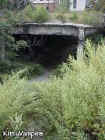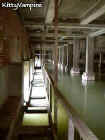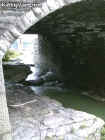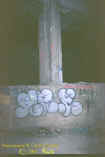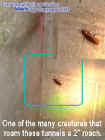|
|
||
|
|
||
|
Rochester NY Was the smallest city to have a transit subway system. In 1927 the tunnels were in operation. The tunnels start around the old court street train station which now seems to be a cute little restaurant. The subway later became abandoned in June 30th 1956 due to the cities industrial grow there was no need for it. From 1956 to 1997 the tunnels were in use basically for freight trains that would unload and load supplies for a newspaper company. Much of what is left today is a crumbling tunnel which houses the cities homeless when you first enter into them. Our organization has not mapped these tunnels although there seems to be many rooms, side tunnels, and docks that can be explored. What makes these tunnels so intimidating is that its blacker then night itself. Once you go deeper down into the abyss of darkness without a light you probably would not find your way out if you did it would be by luck. It is hard to believe that these tunnels are so wide open entering its big entrance with columns supporting a road above where tracks once also existed. When exploring the tunnels when you first enter you can walk the plank above some water missing many boards looking out the beautiful archways at the Genesee river gives it even a bigger thrill. Eventually you go directly above the river itself and after that you enter into the darkness. Rumors of Vampyres, Secret passages, Criminals hiding inside, have been passed around in recent years. But as you go deeper into the tunnels the vandalism lessons as well as the graffiti. Some people really become bold and take there cars inside the opposite end and drive through the tunnels a little ways hence the fact of running into car tire tracks. This is not the type of tunnels you go alone to listening to steam pressure gaskets, homeless people watching you, and not knowing what is lurking in the shadows adds more to the suspense. I do feel that these tunnels are haunted chances are many have died there homeless, homicides, perhaps ghost thinking they still are boarding the subway. This truly is an adventure in itself. Copyright By Rick-AngelOfThyNight
Aqueduct project won't be affected by
work in tunnel
(April 23, 2005) — After more than a decade of debate and studies about what to do with Rochester's old subway tunnel, city leaders say it's time to just fill it with dirt. The $21 million Broad Street Tunnel Project — affecting the portion of the former subway that runs under downtown from Exchange Boulevard to Brown Street — is set to get under way in December. Barring a last-ditch reprieve, the passageway, which also follows the site of the original Erie Canal through the city, will be packed tight with dirt, burying part of Rochester's long-forgotten salad days. The decision has sparked some outcry from history buffs and community activists who say the move is shortsighted and will one day be regretted. But city officials argue that the abandoned tunnel is a safety hazard and too expensive to maintain. Colorful ideas to reuse the milelong passageway as an open canal or as part of a light rail system have languished, with no one stepping forward with the substantial money that would be needed. It's time, city officials say, for action. "It would be nice if someone had $200 million to re-establish the canal as a tourist attraction or $50 million to establish a light rail system, but we just can't hang on to it," said Edward Doherty, the city commissioner of environmental services. The project That work will go on basically out of sight from the public. But people will see some visible changes above ground: The city will install vintage lighting, new curbs, pavement, sidewalks and trees along the route. There also are plans for signs detailing the area's historical importance. Most of the cost, $19.9 million, will be paid
by the federal and state governments, with the city and county picking
up the rest. Thomas Hack, the city's chief structural
engineer, said the city will likely offer public tours of the Broad
Street tunnel before the work begins. History But all the lift bridges disrupted street traffic and it was considered "a blighted, unsightly mess," according to Canal Boats, Interurbans & Trolleys: The Story of the Rochester Subway, a 1985 book published by the Rochester Chapter of the National Railway Historical Society. The canal was relocated south in the early
1900s, and the last canal boat traveled through downtown in 1919. From 1927 to 1956, the tunnel served as part of the streetcar system, a source of pride considering Rochester was one of the smallest cities in the country with a subway. It even spawned a short movie: The End of the Line — Rochester's Subway. Today, the passageway is desolate, spooky and in many areas pitch-dark — a haven for the homeless, graffiti artists, urban spelunkers and an occasional paintball game. It hasn't been used since 1997, when the Democrat and Chronicle stopped storing paper there. It's filled with dust and fallen bits of the concrete ceiling. Stairwells have been walled off or, where still visible, rusted steps lead to nowhere. Some of the steel rails are missing, likely yanked out by scavengers looking for quick cash. Many people are unaware of the passageway's
history. The columns and road deck were last repaired in the late 1970s at a cost of more than $7 million. A study completed earlier this year estimated it would cost $24.2 million to completely repair it today. City officials estimate that they would have to
pump $15 million or so into maintenance every 15 years. Shortsighted? With the emergence of the Susan B. Anthony neighborhood and other historically significant sites on the west side, coupled with increased interest in the Erie Canal, city leaders should use the tunnel to take advantage of heritage tourism, he said. "The ingredients for a historic district
are in place," said Curran, who's pushing for a moratorium on the
work. He still has numerous photos of those days and
talks about the subway often. As for the latest decision, he's a bit
melancholy. "But that's the way it goes." "It's not about just putting water in an
old canal bed," he said. "It's not about restoring the past.
It's all about the future of downtown."
|
||
|
|
|






